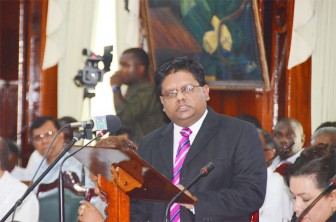VAT and Excise Tax raked in $53 billion in 2011, an increase of 9.7 percent over the takings of 2010, in a year when the Guyana economy recorded 5.4 percent growth, with the non-sugar economy achieving even more rapid growth at 5.6 percent.
This is in a year that saw mixed fortunes in agriculture production and better outcomes for mining and gold, even though bauxite continues to be precarious, Minister of Finance Dr Ashni Singh said yesterday as he revealed a budget of $192.8 billion in the National Assembly.

Inflation for 2011 was recorded at 3.3 percent and this, Singh said, remained “within acceptable norms.” He added that the inflation achieved was due to government’s interventions to lower taxes charged on imported fuel and to provide financial support to GPL.
According to the Minister, central government revenue in 2011 amounted to $120.9 billion, 12.1 percent over 2010, and this he attributed to enhanced collections among both tax and non-tax categories. “Tax revenue collections accounted for 92.1 percent or $111.4 billion of total revenue collections, an increase of $10.5 billion while non-tax collections increased by 37.5 percent to $9.5 billion,” he noted.
He said that internal revenue collections amounted to $47.2 billion, an increase of $3.9 billion over 2010 collections.
“This is on account of continued robust performance of the private sector, with corporation tax and income tax from the self employed increasing by 3 percent and 16.6 percent respectively to $17.5 billion and $2.8 billion,” he added.
“Withholding tax collections amounted to $5 billion, a 49.8 percent increase, which was the result of a substantial payment made by a local manufacturing company to its overseas parent company with respect to dividend payments for previous years coupled with the increase in gold production,” he further said.
VAT/Excise Tax
Instead of announcing new public sector wages, Singh spoke of an eight percent across the board public sector wage increase given at the beginning of 2011. “Mr. Speaker, Government reaffirmed its commitment to improving the livelihood of public servants, teachers, and members of the disciplined services with the granting of an 8 percent across the board increase on the level of wages and salaries effective from the start of 2011,” he said.
He also announced that personal income tax collections exceeded 2010 collections by $1.4 billion with both the private and public sector remitting higher levels. “Customs and trade taxes amounted to $11.1 billion, representing a 19.9 percent increase, mainly attributed to an 18.8 percent increase in import duties to $9.9 billion consistent with higher imports of capital, intermediate and consumption goods,” the Minister said.
Singh disclosed that VAT and excise tax collections increased by 9.7 percent to $53 billion, as VAT on imports of goods recorded (net of refunds) an increase of $3.1 billion or 21 percent above 2010, “consistent with the higher level of imports as the mining, agricultural and telecommunication sectors increased their demand for several commodities.”
He added that VAT on domestic supply of goods amounted to $13.1 billion or 7.7 percent above 2010. “Moreover, excise tax collections on motor vehicles increased by $106.3 million reflecting the returns of the modernisation of motor vehicle registration process and a higher level of imports. On the other hand excise tax collections on petrol decreased by $299.5 million due to comparably lower tax rates,” he said.
Singh also said that interest rates continued to trend downwards, with the commercial banks weighted average lending rate declining by 27 basis points to 11.68 percent, while the small savings rate declined by 68 basis points to 1.99 percent reflecting the continued availability of liquidity in the banking system.
“In addition, the 91-day Treasury bill rate also declined in 2011 by 143 basis points to 2.35 percent reflecting the intense level of competitive bidding for Treasury Bills. These developments helped to facilitate the growth observed in private sector credit,” he said.
Singh announced that the fiscal deficit of the non-financial public sector amounted to $22.9 billion or 4.4 percent of GDP compared to 3.6 percent in 2010.
He said non-interest current expenditure increased by 17.9 percent to $92.5 billion, as a result of wages and salaries, other goods and services, and transfer payments growing by 10.5 percent, 25.6 percent and 17.9 percent respectively.
“The 10.5 percent increase in wages and salaries is primarily attributed to the 8 percent granted to public servants and teachers nationwide, along with an increase in the number of employees entering the public sector,” he said.
Other goods and services increased to $33.7 billion mainly due to increased Government services along with higher contributions towards electricity charges for government agencies, and the conduct of the National Elections.
Transfer payments increased to $27.5 billion due to a $1.5 billion subsidy given to GPL, higher contributions being made for community power in Linden and Kwakwani,” he added.
Public enterprises’ deficit
Singh said that at the end of 2011, public enterprises realised an overall deficit of $6.6 billion, compared to $2.8 billion in 2010. “This was mainly attributed to the higher acquisition cost of fuel, affecting all public enterprises and in particular the Guyana Power and Light Inc.
(GPL), which recorded a deficit of $3.2 billion compared to a surplus of $1.5 billion in 2010,” he said.
The Minister announced also that although the Guyana Sugar Corporation Inc. (GuySuCo) recorded in-creased production in 2011, the company’s operations still generated an overall deficit of $2.1 billion.
The Minister said that at the end of 2011, Guyana’s external debt stock grew by 16 percent to US$1.2 billion, primarily due to new disbursements of project loans. The budget revealed that Guyana’s domestic debt stock increased moderately by 2.2 percent to US$728 million at the end of 2011.




